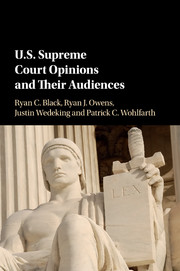Book contents
- Frontmatter
- Dedication
- Contents
- Acknowledgement
- 1 Introduction
- 2 A theory: using opinion clarity to enhance compliance and manage public support
- 3 Estimating the clarity of Supreme Court opinions
- 4 Supreme Court opinions and federal circuit courts
- 5 Supreme Court opinions and federal agency implementors
- 6 Supreme Court opinions and the states
- 7 Supreme Court opinions and the secondary population
- 8 Establishing compliance as a function of clarity
- 9 Conclusion
- References
- Index
8 - Establishing compliance as a function of clarity
Published online by Cambridge University Press: 05 February 2016
- Frontmatter
- Dedication
- Contents
- Acknowledgement
- 1 Introduction
- 2 A theory: using opinion clarity to enhance compliance and manage public support
- 3 Estimating the clarity of Supreme Court opinions
- 4 Supreme Court opinions and federal circuit courts
- 5 Supreme Court opinions and federal agency implementors
- 6 Supreme Court opinions and the states
- 7 Supreme Court opinions and the secondary population
- 8 Establishing compliance as a function of clarity
- 9 Conclusion
- References
- Index
Summary
The thrust of this book focuses on how justices seek to enhance compliance with their decisions and manage negative responses to Court decisions by adapting the clarity of their opinions to fit the context. And, the results have been supportive. In this chapter, we do something different. Here, we seek to assure the reader that opinion clarity can actually enhance compliance.
While there are a number of ways to check whether clarity induces compliance, we perform two tests. First, we examine whether clearer Supreme Court opinions induce greater compliance among lower federal court judges. As we demonstrate in Chapter 4, Supreme Court justices alter the clarity of their precedent-setting opinions when they have greater reason to expect circuit court judges will produce legal conflicts and shirk precedents. In this chapter, we take this examination one step farther. We consider whether federal circuit courts are in fact more likely to comply with clearer Supreme Court opinions. Second, we perform a study in which we ask survey respondents to read excerpts of opinions and rate whether they or others would comply. These results, like our statistical model of actual lower court compliance, show that people are less likely to comply with unclear opinions.
Modeling lower court compliance as a function of opinion clarity
We began by drawing a random sample of more than 500 Supreme Court opinions decided between the 1953 and 2000 terms. We choose these terms as bookends because 1953 corresponds to what scholars acknowledge as the beginning of the modern Supreme Court. We pick 2000 as the most recent term to ensure the opinions had sufficient opportunity to filter down to the lower courts and be treated by them. Next, to observe whether lower courts are more likely to treat (i.e., apply) clearer opinions positively than unclear opinions, we identify the approximately 9,500 federal circuit court cases that later applied those 500 Supreme Court precedents.
Our dependent variable accounts for whether the lower court positively treated the Supreme Court precedent, negatively treated it, or treated it neutrally. More specifically, using the Shepard's categories, a decision that “followed” a Supreme Court precedent is a positive application. A decision that “explained” or “harmonized” a precedent reflects a neutral application. And, a decision that “overruled,” “criticized,” “questioned,” “limited,” “superseded,” or “distinguished” a precedent represents a negative application.
- Type
- Chapter
- Information
- US Supreme Court Opinions and their Audiences , pp. 141 - 155Publisher: Cambridge University PressPrint publication year: 2016

